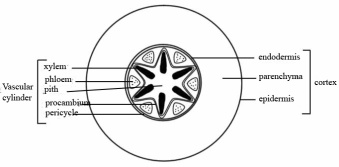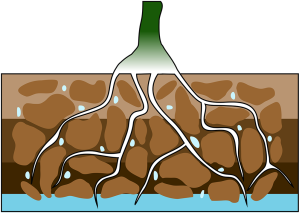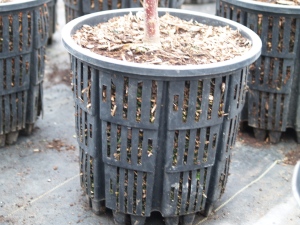 It pays to know something about the anatomy and physiology of roots when it comes to developing the root system of Bonsai trees. It is said that a tree mimics its above ground growth to what happens with root growth below ground level. This might be true for trees in nature, but with Bonsai it could be quite different due to the fact that we prune the roots and the roots also have to grow in a confined space.
It pays to know something about the anatomy and physiology of roots when it comes to developing the root system of Bonsai trees. It is said that a tree mimics its above ground growth to what happens with root growth below ground level. This might be true for trees in nature, but with Bonsai it could be quite different due to the fact that we prune the roots and the roots also have to grow in a confined space.
When a root is studied under a microscope it is clear that there  are different tissue types present in different areas of the root. On the outside is an epidermis layer consisting of cells. To increase the surface area, and therefore the absorptive area of the root, extensions of these epidermal cells grow into the soil. These are the root hairs. The main job of the root hairs is to absorb water and nutrients. They are very small and fragile and normally breaks off when a plant is pulled from the soil. This is a very good reason to be gentle when a plant is uprooted and when soil is removed from the roots.
are different tissue types present in different areas of the root. On the outside is an epidermis layer consisting of cells. To increase the surface area, and therefore the absorptive area of the root, extensions of these epidermal cells grow into the soil. These are the root hairs. The main job of the root hairs is to absorb water and nutrients. They are very small and fragile and normally breaks off when a plant is pulled from the soil. This is a very good reason to be gentle when a plant is uprooted and when soil is removed from the roots.
The next layer under the epidermis is the cortex. These cells are loosely spaced to allow for the movement of gasses and dissolved nutrients to the core of the root. The middle part (core or stele) of the root consists of the vascular tissues, the xylem and the phloem. The xylem particularly is of importance here as it is through this tissue that the water and nutrients are transported to the rest of the plant. Around the vascular tissue is another layer of cells, called the endodermis and underneath this is the pericycle.
This pericycle is of particular importance to the plant and Bonsai artists as this is where lateral roots originate from. The origin of the lateral roots is therefore situated deep inside the root structure and not like the branches or side shoots of the plant that originates from adventitious buds. The only reason for this that I can think of is that it provides better protection for the roots. It also means that the vascular tissue is in close contact with the lateral root.
If the root is studied externally the branching of roots can be seen as starting a little bit further back up the root and not right from the root tip. The same mechanism that applies to pruning above ground is also evident here. When the apical meristem (in the root tip) is removed, the pericycle is stimulated to grow more roots. This is also due to the influence or the lack of this influence, of plant hormones. This is the science behind root pruning. When a root is pruned, more roots will grow from that area. It will help if rooting hormone is applied to the cut area as this will help to stimulate the pericycle to produce more roots. Ensure that the rooting hormone is applied evenly for an even spread of new roots. There is some evidence that when the rooting hormone is applied to only one side of a root, that more new roots will grow on that side. I will experiment with this and report back on findings.
The term air pruning has also been used in the propagation of plants. This method can be used for Bonsai as well, especially during the early phases of development where the emphasis is on the development of branches as well as the root system. It simply means planting the tree in a container with holes in it. The roots will grow to the edge of the container and either split or not grow any further.
 It was mentioned earlier that the removal of the root tip (apical meristem) will stimulate the pericycle to grow more roots. This is also true when the apical meristem is damaged. Growing the tree in a soil medium with lots of granular particles can cause the root tip to split or damage it and this will in turn stimulate more lateral roots to grow.
It was mentioned earlier that the removal of the root tip (apical meristem) will stimulate the pericycle to grow more roots. This is also true when the apical meristem is damaged. Growing the tree in a soil medium with lots of granular particles can cause the root tip to split or damage it and this will in turn stimulate more lateral roots to grow.
Also of note here is that the majority of water and nutrients are absorbed through the root hairs. As these are usually in the vicinity of the root tip (directly behind it), it can be taken for granted that these root hairs will be removed or reduced when root pruning. The uptake of water and nutrients will therefore be compromised when root pruning takes place. Be vigilant. This is the reason why the tree should be watered well and placed in the shade after root pruning. Water loss through transpiration must be avoided. Factors that increase transpiration are heat, wind and leaf surface area. It is therefore a good idea to reduce the leaves after root pruning in the case of deciduous trees. This might be another reason for re-potting and root pruning in spring before the leaves are fully grown.
 As roots age, they undergo secondary growth or secondary thickening. This is basically when the softer tissue becomes woody and bark is formed. This happens faster with exposed roots. The main thing to remember here is that older roots that have gone through this process will not absorb water and nutrients. When root pruning, this needs to be taken into consideration. Always leave some of the younger, finer roots to provide the plant with water and nutrients.
As roots age, they undergo secondary growth or secondary thickening. This is basically when the softer tissue becomes woody and bark is formed. This happens faster with exposed roots. The main thing to remember here is that older roots that have gone through this process will not absorb water and nutrients. When root pruning, this needs to be taken into consideration. Always leave some of the younger, finer roots to provide the plant with water and nutrients.




Reblogged this on Wolf's Birding and Bonsai Blog.
LikeLike
Beautifully explained with simple language and diagrams, greatly enjoying this blog….so often we are told we must do “this” and “that” with our bonsai, thanks for explaining why!
LikeLike
Thank you. It must be the teacher in me wanting to explain things.
LikeLike